Taxation Report: Assessing Mr. Desai's Tax Liabilities
VerifiedAdded on 2020/12/09
|9
|2490
|250
Report
AI Summary
This report, prepared for a trainee tax manager, assesses the tax liabilities of Mr. Desai, a client who collects and restores antiques. The report addresses key aspects of taxation, including the classification of Mr. Desai's vocation as a trade, differentiating between tax evasion and avoidance, and advising on allowable expenditures and the calculation of trading profits. The report also covers Value Added Tax (VAT), detailing when Mr. Desai should register, submit quarterly liabilities, and the benefits of the flat rate scheme. Finally, the report offers advice on managing customer payment defaults. The analysis is based on UK tax regulations and HMRC guidelines, providing a comprehensive overview of Mr. Desai's tax situation and obligations.
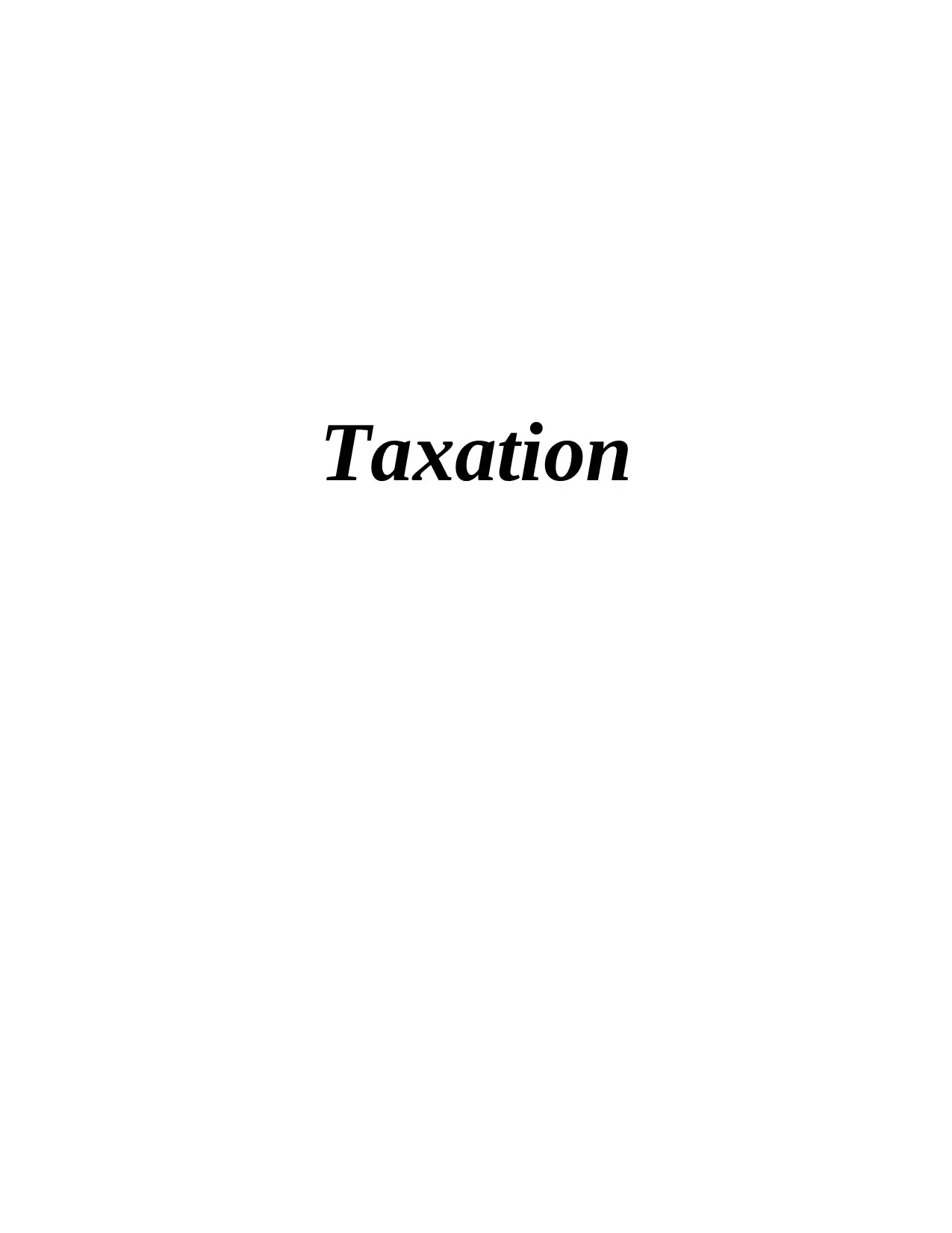
Taxation
Paraphrase This Document
Need a fresh take? Get an instant paraphrase of this document with our AI Paraphraser
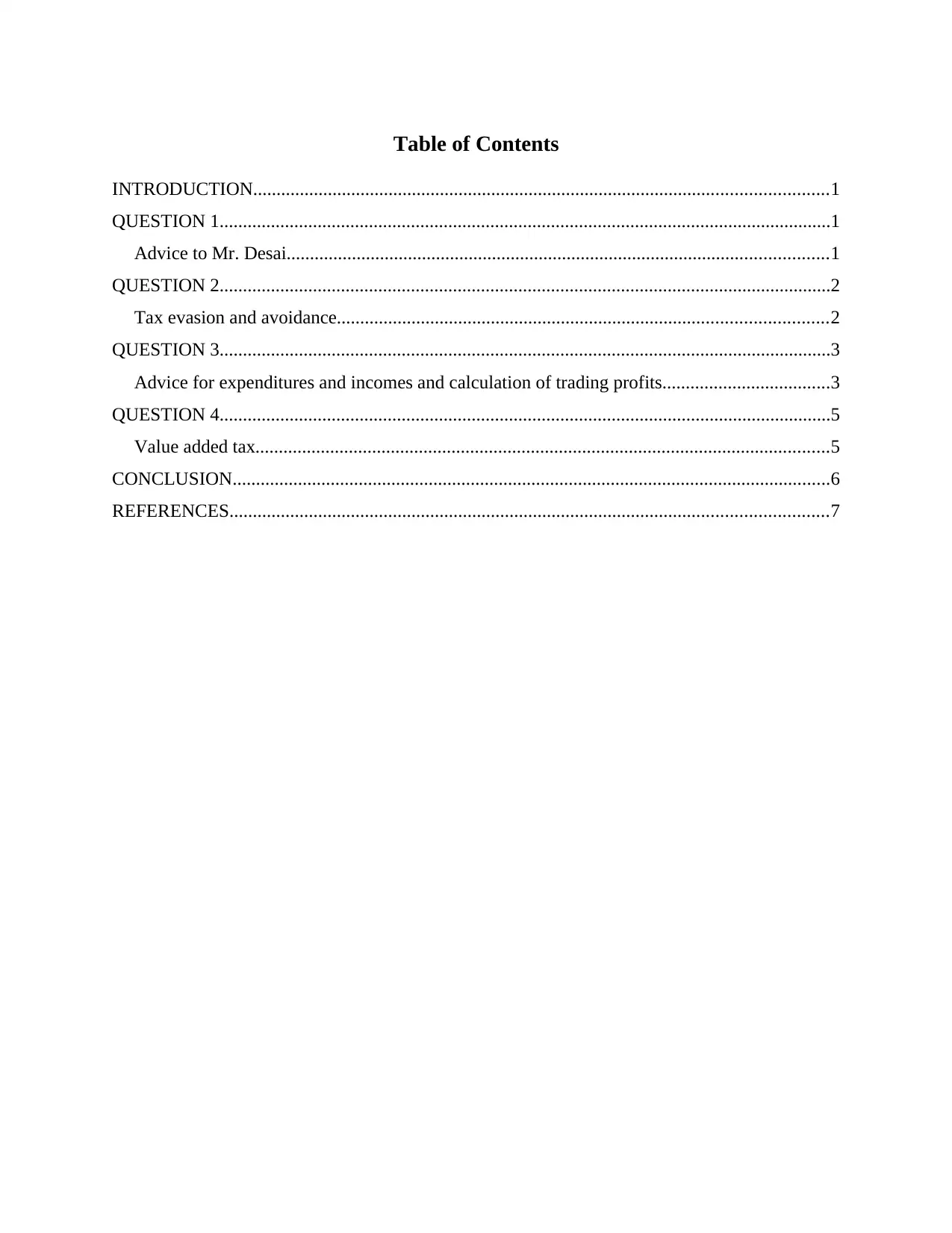
Table of Contents
INTRODUCTION...........................................................................................................................1
QUESTION 1...................................................................................................................................1
Advice to Mr. Desai....................................................................................................................1
QUESTION 2...................................................................................................................................2
Tax evasion and avoidance.........................................................................................................2
QUESTION 3...................................................................................................................................3
Advice for expenditures and incomes and calculation of trading profits....................................3
QUESTION 4...................................................................................................................................5
Value added tax...........................................................................................................................5
CONCLUSION................................................................................................................................6
REFERENCES................................................................................................................................7
INTRODUCTION...........................................................................................................................1
QUESTION 1...................................................................................................................................1
Advice to Mr. Desai....................................................................................................................1
QUESTION 2...................................................................................................................................2
Tax evasion and avoidance.........................................................................................................2
QUESTION 3...................................................................................................................................3
Advice for expenditures and incomes and calculation of trading profits....................................3
QUESTION 4...................................................................................................................................5
Value added tax...........................................................................................................................5
CONCLUSION................................................................................................................................6
REFERENCES................................................................................................................................7
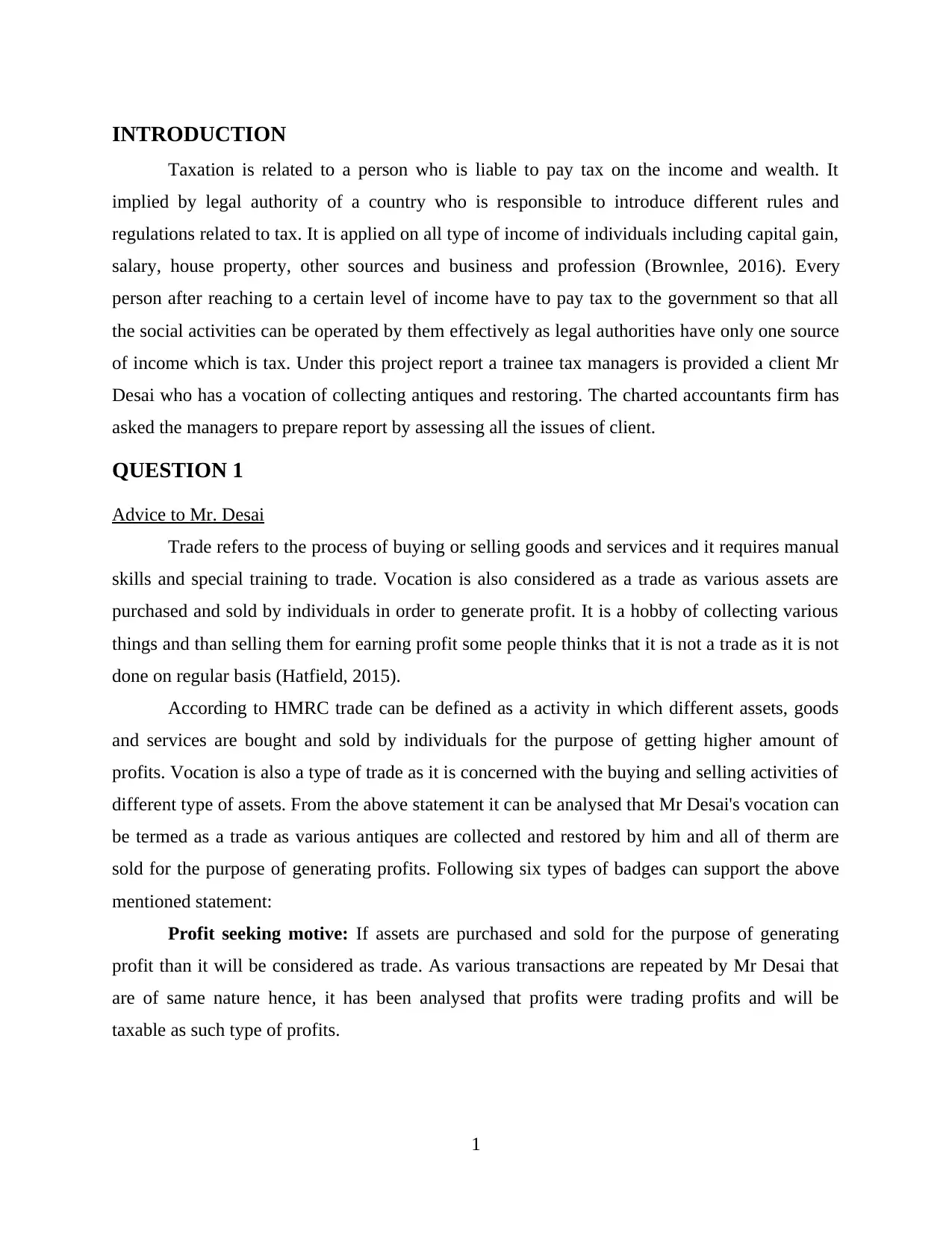
INTRODUCTION
Taxation is related to a person who is liable to pay tax on the income and wealth. It
implied by legal authority of a country who is responsible to introduce different rules and
regulations related to tax. It is applied on all type of income of individuals including capital gain,
salary, house property, other sources and business and profession (Brownlee, 2016). Every
person after reaching to a certain level of income have to pay tax to the government so that all
the social activities can be operated by them effectively as legal authorities have only one source
of income which is tax. Under this project report a trainee tax managers is provided a client Mr
Desai who has a vocation of collecting antiques and restoring. The charted accountants firm has
asked the managers to prepare report by assessing all the issues of client.
QUESTION 1
Advice to Mr. Desai
Trade refers to the process of buying or selling goods and services and it requires manual
skills and special training to trade. Vocation is also considered as a trade as various assets are
purchased and sold by individuals in order to generate profit. It is a hobby of collecting various
things and than selling them for earning profit some people thinks that it is not a trade as it is not
done on regular basis (Hatfield, 2015).
According to HMRC trade can be defined as a activity in which different assets, goods
and services are bought and sold by individuals for the purpose of getting higher amount of
profits. Vocation is also a type of trade as it is concerned with the buying and selling activities of
different type of assets. From the above statement it can be analysed that Mr Desai's vocation can
be termed as a trade as various antiques are collected and restored by him and all of therm are
sold for the purpose of generating profits. Following six types of badges can support the above
mentioned statement:
Profit seeking motive: If assets are purchased and sold for the purpose of generating
profit than it will be considered as trade. As various transactions are repeated by Mr Desai that
are of same nature hence, it has been analysed that profits were trading profits and will be
taxable as such type of profits.
1
Taxation is related to a person who is liable to pay tax on the income and wealth. It
implied by legal authority of a country who is responsible to introduce different rules and
regulations related to tax. It is applied on all type of income of individuals including capital gain,
salary, house property, other sources and business and profession (Brownlee, 2016). Every
person after reaching to a certain level of income have to pay tax to the government so that all
the social activities can be operated by them effectively as legal authorities have only one source
of income which is tax. Under this project report a trainee tax managers is provided a client Mr
Desai who has a vocation of collecting antiques and restoring. The charted accountants firm has
asked the managers to prepare report by assessing all the issues of client.
QUESTION 1
Advice to Mr. Desai
Trade refers to the process of buying or selling goods and services and it requires manual
skills and special training to trade. Vocation is also considered as a trade as various assets are
purchased and sold by individuals in order to generate profit. It is a hobby of collecting various
things and than selling them for earning profit some people thinks that it is not a trade as it is not
done on regular basis (Hatfield, 2015).
According to HMRC trade can be defined as a activity in which different assets, goods
and services are bought and sold by individuals for the purpose of getting higher amount of
profits. Vocation is also a type of trade as it is concerned with the buying and selling activities of
different type of assets. From the above statement it can be analysed that Mr Desai's vocation can
be termed as a trade as various antiques are collected and restored by him and all of therm are
sold for the purpose of generating profits. Following six types of badges can support the above
mentioned statement:
Profit seeking motive: If assets are purchased and sold for the purpose of generating
profit than it will be considered as trade. As various transactions are repeated by Mr Desai that
are of same nature hence, it has been analysed that profits were trading profits and will be
taxable as such type of profits.
1
⊘ This is a preview!⊘
Do you want full access?
Subscribe today to unlock all pages.

Trusted by 1+ million students worldwide
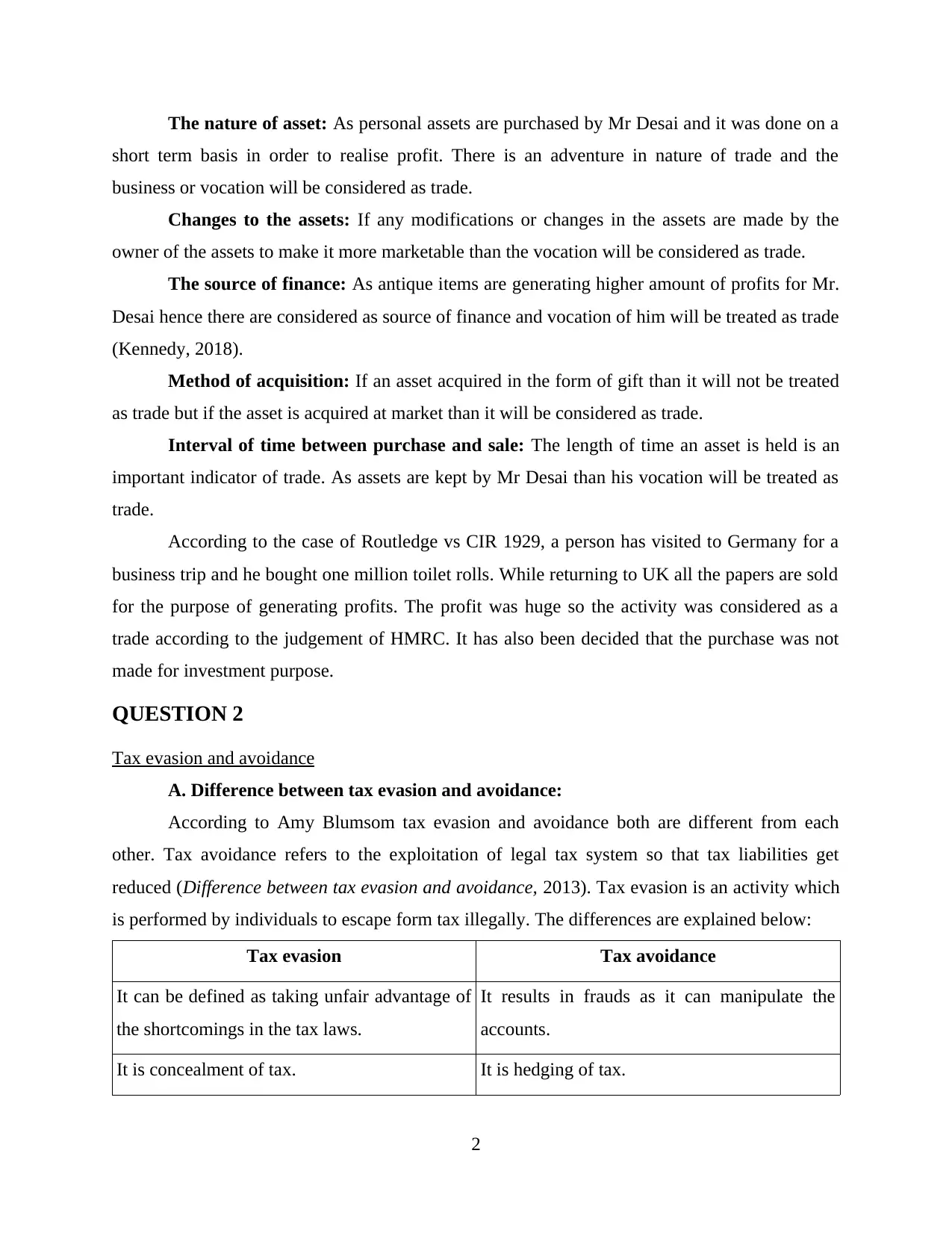
The nature of asset: As personal assets are purchased by Mr Desai and it was done on a
short term basis in order to realise profit. There is an adventure in nature of trade and the
business or vocation will be considered as trade.
Changes to the assets: If any modifications or changes in the assets are made by the
owner of the assets to make it more marketable than the vocation will be considered as trade.
The source of finance: As antique items are generating higher amount of profits for Mr.
Desai hence there are considered as source of finance and vocation of him will be treated as trade
(Kennedy, 2018).
Method of acquisition: If an asset acquired in the form of gift than it will not be treated
as trade but if the asset is acquired at market than it will be considered as trade.
Interval of time between purchase and sale: The length of time an asset is held is an
important indicator of trade. As assets are kept by Mr Desai than his vocation will be treated as
trade.
According to the case of Routledge vs CIR 1929, a person has visited to Germany for a
business trip and he bought one million toilet rolls. While returning to UK all the papers are sold
for the purpose of generating profits. The profit was huge so the activity was considered as a
trade according to the judgement of HMRC. It has also been decided that the purchase was not
made for investment purpose.
QUESTION 2
Tax evasion and avoidance
A. Difference between tax evasion and avoidance:
According to Amy Blumsom tax evasion and avoidance both are different from each
other. Tax avoidance refers to the exploitation of legal tax system so that tax liabilities get
reduced (Difference between tax evasion and avoidance, 2013). Tax evasion is an activity which
is performed by individuals to escape form tax illegally. The differences are explained below:
Tax evasion Tax avoidance
It can be defined as taking unfair advantage of
the shortcomings in the tax laws.
It results in frauds as it can manipulate the
accounts.
It is concealment of tax. It is hedging of tax.
2
short term basis in order to realise profit. There is an adventure in nature of trade and the
business or vocation will be considered as trade.
Changes to the assets: If any modifications or changes in the assets are made by the
owner of the assets to make it more marketable than the vocation will be considered as trade.
The source of finance: As antique items are generating higher amount of profits for Mr.
Desai hence there are considered as source of finance and vocation of him will be treated as trade
(Kennedy, 2018).
Method of acquisition: If an asset acquired in the form of gift than it will not be treated
as trade but if the asset is acquired at market than it will be considered as trade.
Interval of time between purchase and sale: The length of time an asset is held is an
important indicator of trade. As assets are kept by Mr Desai than his vocation will be treated as
trade.
According to the case of Routledge vs CIR 1929, a person has visited to Germany for a
business trip and he bought one million toilet rolls. While returning to UK all the papers are sold
for the purpose of generating profits. The profit was huge so the activity was considered as a
trade according to the judgement of HMRC. It has also been decided that the purchase was not
made for investment purpose.
QUESTION 2
Tax evasion and avoidance
A. Difference between tax evasion and avoidance:
According to Amy Blumsom tax evasion and avoidance both are different from each
other. Tax avoidance refers to the exploitation of legal tax system so that tax liabilities get
reduced (Difference between tax evasion and avoidance, 2013). Tax evasion is an activity which
is performed by individuals to escape form tax illegally. The differences are explained below:
Tax evasion Tax avoidance
It can be defined as taking unfair advantage of
the shortcomings in the tax laws.
It results in frauds as it can manipulate the
accounts.
It is concealment of tax. It is hedging of tax.
2
Paraphrase This Document
Need a fresh take? Get an instant paraphrase of this document with our AI Paraphraser
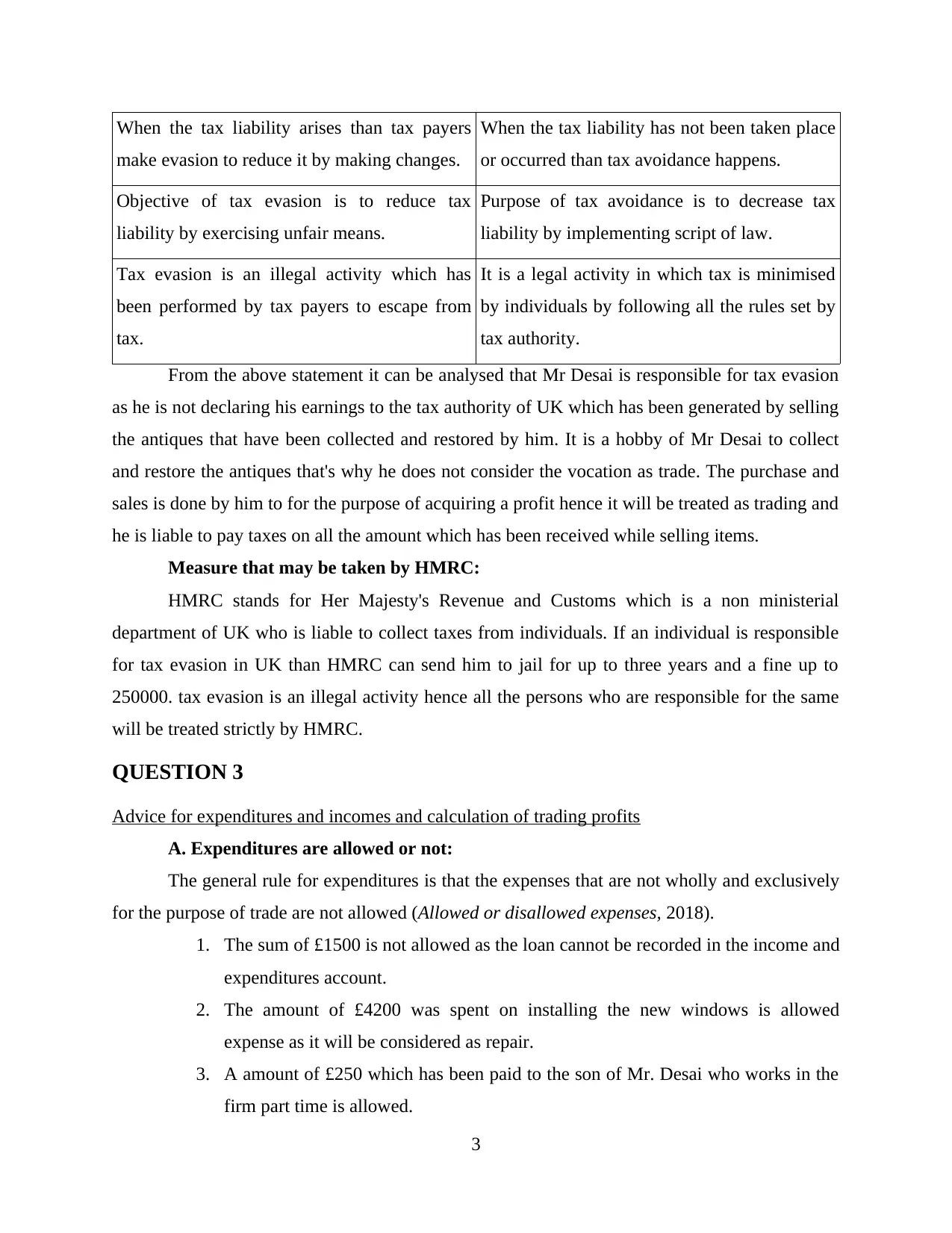
When the tax liability arises than tax payers
make evasion to reduce it by making changes.
When the tax liability has not been taken place
or occurred than tax avoidance happens.
Objective of tax evasion is to reduce tax
liability by exercising unfair means.
Purpose of tax avoidance is to decrease tax
liability by implementing script of law.
Tax evasion is an illegal activity which has
been performed by tax payers to escape from
tax.
It is a legal activity in which tax is minimised
by individuals by following all the rules set by
tax authority.
From the above statement it can be analysed that Mr Desai is responsible for tax evasion
as he is not declaring his earnings to the tax authority of UK which has been generated by selling
the antiques that have been collected and restored by him. It is a hobby of Mr Desai to collect
and restore the antiques that's why he does not consider the vocation as trade. The purchase and
sales is done by him to for the purpose of acquiring a profit hence it will be treated as trading and
he is liable to pay taxes on all the amount which has been received while selling items.
Measure that may be taken by HMRC:
HMRC stands for Her Majesty's Revenue and Customs which is a non ministerial
department of UK who is liable to collect taxes from individuals. If an individual is responsible
for tax evasion in UK than HMRC can send him to jail for up to three years and a fine up to
250000. tax evasion is an illegal activity hence all the persons who are responsible for the same
will be treated strictly by HMRC.
QUESTION 3
Advice for expenditures and incomes and calculation of trading profits
A. Expenditures are allowed or not:
The general rule for expenditures is that the expenses that are not wholly and exclusively
for the purpose of trade are not allowed (Allowed or disallowed expenses, 2018).
1. The sum of £1500 is not allowed as the loan cannot be recorded in the income and
expenditures account.
2. The amount of £4200 was spent on installing the new windows is allowed
expense as it will be considered as repair.
3. A amount of £250 which has been paid to the son of Mr. Desai who works in the
firm part time is allowed.
3
make evasion to reduce it by making changes.
When the tax liability has not been taken place
or occurred than tax avoidance happens.
Objective of tax evasion is to reduce tax
liability by exercising unfair means.
Purpose of tax avoidance is to decrease tax
liability by implementing script of law.
Tax evasion is an illegal activity which has
been performed by tax payers to escape from
tax.
It is a legal activity in which tax is minimised
by individuals by following all the rules set by
tax authority.
From the above statement it can be analysed that Mr Desai is responsible for tax evasion
as he is not declaring his earnings to the tax authority of UK which has been generated by selling
the antiques that have been collected and restored by him. It is a hobby of Mr Desai to collect
and restore the antiques that's why he does not consider the vocation as trade. The purchase and
sales is done by him to for the purpose of acquiring a profit hence it will be treated as trading and
he is liable to pay taxes on all the amount which has been received while selling items.
Measure that may be taken by HMRC:
HMRC stands for Her Majesty's Revenue and Customs which is a non ministerial
department of UK who is liable to collect taxes from individuals. If an individual is responsible
for tax evasion in UK than HMRC can send him to jail for up to three years and a fine up to
250000. tax evasion is an illegal activity hence all the persons who are responsible for the same
will be treated strictly by HMRC.
QUESTION 3
Advice for expenditures and incomes and calculation of trading profits
A. Expenditures are allowed or not:
The general rule for expenditures is that the expenses that are not wholly and exclusively
for the purpose of trade are not allowed (Allowed or disallowed expenses, 2018).
1. The sum of £1500 is not allowed as the loan cannot be recorded in the income and
expenditures account.
2. The amount of £4200 was spent on installing the new windows is allowed
expense as it will be considered as repair.
3. A amount of £250 which has been paid to the son of Mr. Desai who works in the
firm part time is allowed.
3
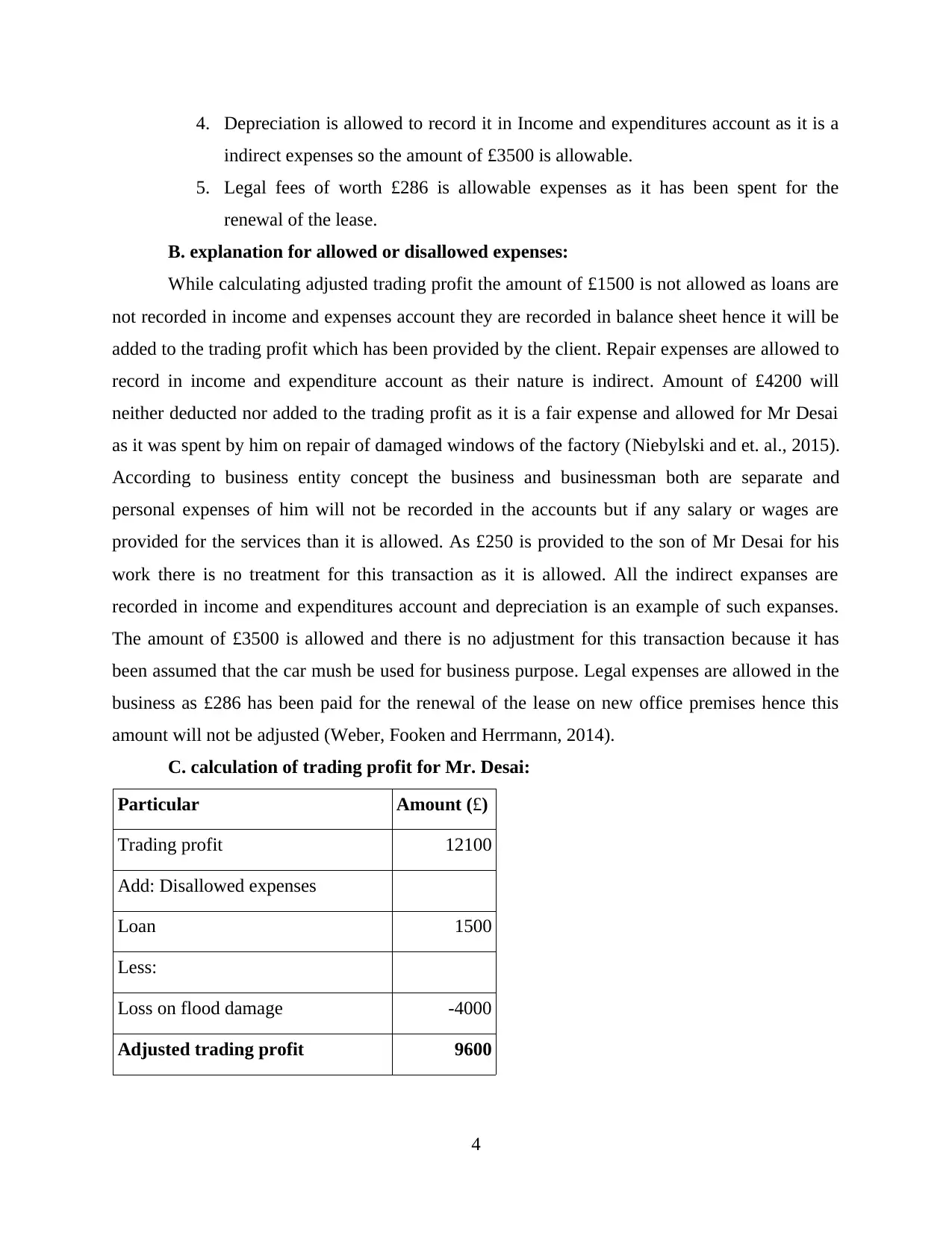
4. Depreciation is allowed to record it in Income and expenditures account as it is a
indirect expenses so the amount of £3500 is allowable.
5. Legal fees of worth £286 is allowable expenses as it has been spent for the
renewal of the lease.
B. explanation for allowed or disallowed expenses:
While calculating adjusted trading profit the amount of £1500 is not allowed as loans are
not recorded in income and expenses account they are recorded in balance sheet hence it will be
added to the trading profit which has been provided by the client. Repair expenses are allowed to
record in income and expenditure account as their nature is indirect. Amount of £4200 will
neither deducted nor added to the trading profit as it is a fair expense and allowed for Mr Desai
as it was spent by him on repair of damaged windows of the factory (Niebylski and et. al., 2015).
According to business entity concept the business and businessman both are separate and
personal expenses of him will not be recorded in the accounts but if any salary or wages are
provided for the services than it is allowed. As £250 is provided to the son of Mr Desai for his
work there is no treatment for this transaction as it is allowed. All the indirect expanses are
recorded in income and expenditures account and depreciation is an example of such expanses.
The amount of £3500 is allowed and there is no adjustment for this transaction because it has
been assumed that the car mush be used for business purpose. Legal expenses are allowed in the
business as £286 has been paid for the renewal of the lease on new office premises hence this
amount will not be adjusted (Weber, Fooken and Herrmann, 2014).
C. calculation of trading profit for Mr. Desai:
Particular Amount (£)
Trading profit 12100
Add: Disallowed expenses
Loan 1500
Less:
Loss on flood damage -4000
Adjusted trading profit 9600
4
indirect expenses so the amount of £3500 is allowable.
5. Legal fees of worth £286 is allowable expenses as it has been spent for the
renewal of the lease.
B. explanation for allowed or disallowed expenses:
While calculating adjusted trading profit the amount of £1500 is not allowed as loans are
not recorded in income and expenses account they are recorded in balance sheet hence it will be
added to the trading profit which has been provided by the client. Repair expenses are allowed to
record in income and expenditure account as their nature is indirect. Amount of £4200 will
neither deducted nor added to the trading profit as it is a fair expense and allowed for Mr Desai
as it was spent by him on repair of damaged windows of the factory (Niebylski and et. al., 2015).
According to business entity concept the business and businessman both are separate and
personal expenses of him will not be recorded in the accounts but if any salary or wages are
provided for the services than it is allowed. As £250 is provided to the son of Mr Desai for his
work there is no treatment for this transaction as it is allowed. All the indirect expanses are
recorded in income and expenditures account and depreciation is an example of such expanses.
The amount of £3500 is allowed and there is no adjustment for this transaction because it has
been assumed that the car mush be used for business purpose. Legal expenses are allowed in the
business as £286 has been paid for the renewal of the lease on new office premises hence this
amount will not be adjusted (Weber, Fooken and Herrmann, 2014).
C. calculation of trading profit for Mr. Desai:
Particular Amount (£)
Trading profit 12100
Add: Disallowed expenses
Loan 1500
Less:
Loss on flood damage -4000
Adjusted trading profit 9600
4
⊘ This is a preview!⊘
Do you want full access?
Subscribe today to unlock all pages.

Trusted by 1+ million students worldwide
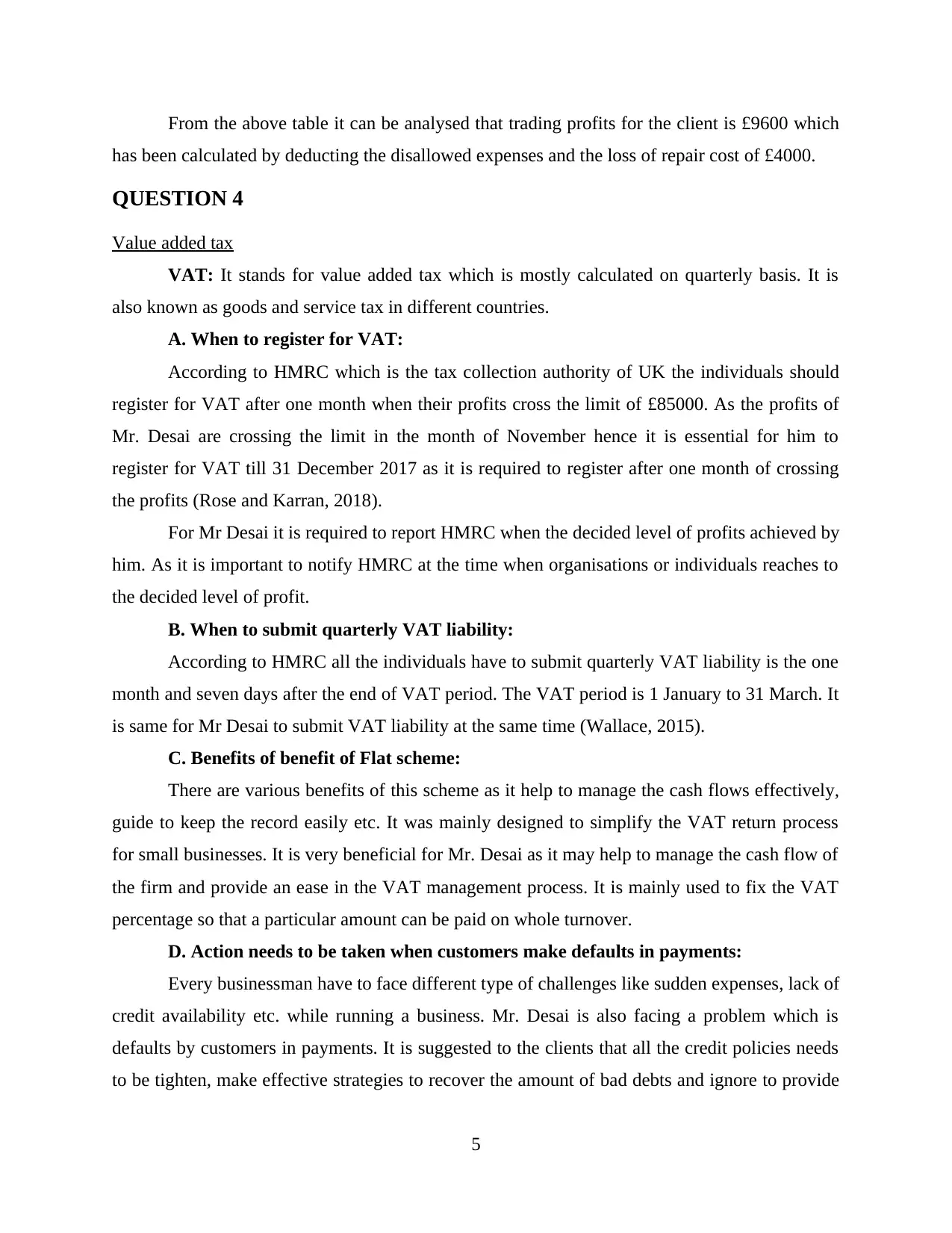
From the above table it can be analysed that trading profits for the client is £9600 which
has been calculated by deducting the disallowed expenses and the loss of repair cost of £4000.
QUESTION 4
Value added tax
VAT: It stands for value added tax which is mostly calculated on quarterly basis. It is
also known as goods and service tax in different countries.
A. When to register for VAT:
According to HMRC which is the tax collection authority of UK the individuals should
register for VAT after one month when their profits cross the limit of £85000. As the profits of
Mr. Desai are crossing the limit in the month of November hence it is essential for him to
register for VAT till 31 December 2017 as it is required to register after one month of crossing
the profits (Rose and Karran, 2018).
For Mr Desai it is required to report HMRC when the decided level of profits achieved by
him. As it is important to notify HMRC at the time when organisations or individuals reaches to
the decided level of profit.
B. When to submit quarterly VAT liability:
According to HMRC all the individuals have to submit quarterly VAT liability is the one
month and seven days after the end of VAT period. The VAT period is 1 January to 31 March. It
is same for Mr Desai to submit VAT liability at the same time (Wallace, 2015).
C. Benefits of benefit of Flat scheme:
There are various benefits of this scheme as it help to manage the cash flows effectively,
guide to keep the record easily etc. It was mainly designed to simplify the VAT return process
for small businesses. It is very beneficial for Mr. Desai as it may help to manage the cash flow of
the firm and provide an ease in the VAT management process. It is mainly used to fix the VAT
percentage so that a particular amount can be paid on whole turnover.
D. Action needs to be taken when customers make defaults in payments:
Every businessman have to face different type of challenges like sudden expenses, lack of
credit availability etc. while running a business. Mr. Desai is also facing a problem which is
defaults by customers in payments. It is suggested to the clients that all the credit policies needs
to be tighten, make effective strategies to recover the amount of bad debts and ignore to provide
5
has been calculated by deducting the disallowed expenses and the loss of repair cost of £4000.
QUESTION 4
Value added tax
VAT: It stands for value added tax which is mostly calculated on quarterly basis. It is
also known as goods and service tax in different countries.
A. When to register for VAT:
According to HMRC which is the tax collection authority of UK the individuals should
register for VAT after one month when their profits cross the limit of £85000. As the profits of
Mr. Desai are crossing the limit in the month of November hence it is essential for him to
register for VAT till 31 December 2017 as it is required to register after one month of crossing
the profits (Rose and Karran, 2018).
For Mr Desai it is required to report HMRC when the decided level of profits achieved by
him. As it is important to notify HMRC at the time when organisations or individuals reaches to
the decided level of profit.
B. When to submit quarterly VAT liability:
According to HMRC all the individuals have to submit quarterly VAT liability is the one
month and seven days after the end of VAT period. The VAT period is 1 January to 31 March. It
is same for Mr Desai to submit VAT liability at the same time (Wallace, 2015).
C. Benefits of benefit of Flat scheme:
There are various benefits of this scheme as it help to manage the cash flows effectively,
guide to keep the record easily etc. It was mainly designed to simplify the VAT return process
for small businesses. It is very beneficial for Mr. Desai as it may help to manage the cash flow of
the firm and provide an ease in the VAT management process. It is mainly used to fix the VAT
percentage so that a particular amount can be paid on whole turnover.
D. Action needs to be taken when customers make defaults in payments:
Every businessman have to face different type of challenges like sudden expenses, lack of
credit availability etc. while running a business. Mr. Desai is also facing a problem which is
defaults by customers in payments. It is suggested to the clients that all the credit policies needs
to be tighten, make effective strategies to recover the amount of bad debts and ignore to provide
5
Paraphrase This Document
Need a fresh take? Get an instant paraphrase of this document with our AI Paraphraser
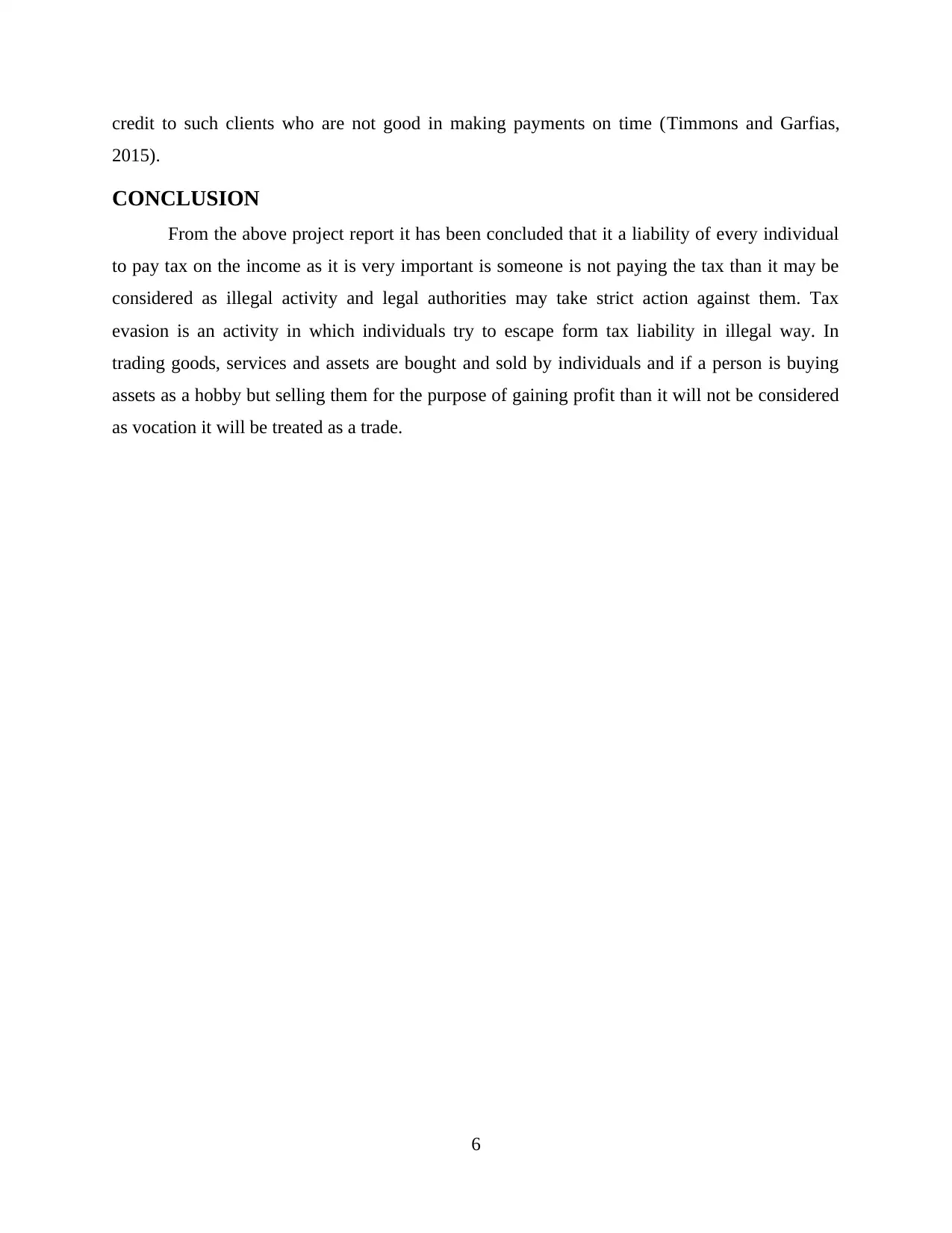
credit to such clients who are not good in making payments on time (Timmons and Garfias,
2015).
CONCLUSION
From the above project report it has been concluded that it a liability of every individual
to pay tax on the income as it is very important is someone is not paying the tax than it may be
considered as illegal activity and legal authorities may take strict action against them. Tax
evasion is an activity in which individuals try to escape form tax liability in illegal way. In
trading goods, services and assets are bought and sold by individuals and if a person is buying
assets as a hobby but selling them for the purpose of gaining profit than it will not be considered
as vocation it will be treated as a trade.
6
2015).
CONCLUSION
From the above project report it has been concluded that it a liability of every individual
to pay tax on the income as it is very important is someone is not paying the tax than it may be
considered as illegal activity and legal authorities may take strict action against them. Tax
evasion is an activity in which individuals try to escape form tax liability in illegal way. In
trading goods, services and assets are bought and sold by individuals and if a person is buying
assets as a hobby but selling them for the purpose of gaining profit than it will not be considered
as vocation it will be treated as a trade.
6
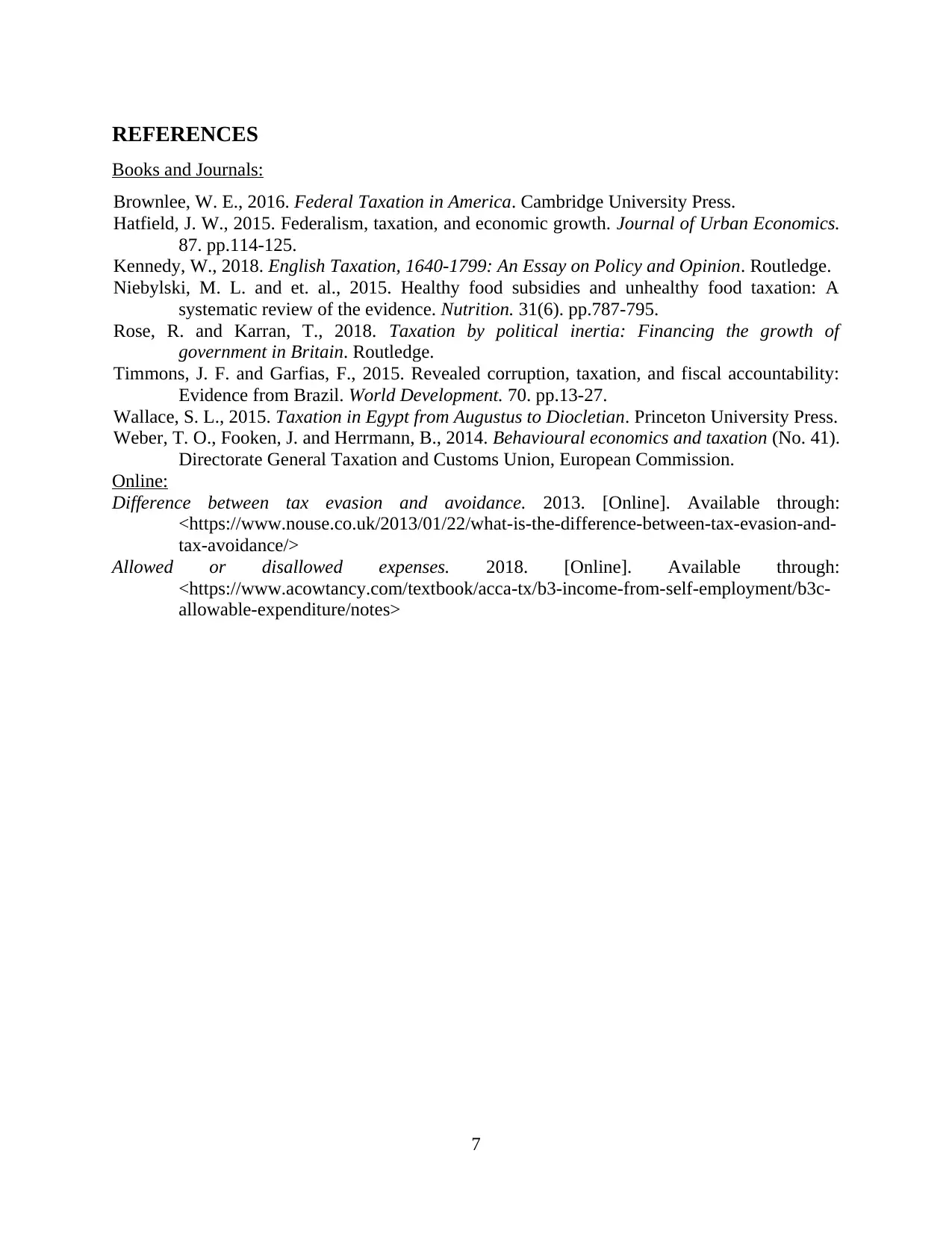
REFERENCES
Books and Journals:
Brownlee, W. E., 2016. Federal Taxation in America. Cambridge University Press.
Hatfield, J. W., 2015. Federalism, taxation, and economic growth. Journal of Urban Economics.
87. pp.114-125.
Kennedy, W., 2018. English Taxation, 1640-1799: An Essay on Policy and Opinion. Routledge.
Niebylski, M. L. and et. al., 2015. Healthy food subsidies and unhealthy food taxation: A
systematic review of the evidence. Nutrition. 31(6). pp.787-795.
Rose, R. and Karran, T., 2018. Taxation by political inertia: Financing the growth of
government in Britain. Routledge.
Timmons, J. F. and Garfias, F., 2015. Revealed corruption, taxation, and fiscal accountability:
Evidence from Brazil. World Development. 70. pp.13-27.
Wallace, S. L., 2015. Taxation in Egypt from Augustus to Diocletian. Princeton University Press.
Weber, T. O., Fooken, J. and Herrmann, B., 2014. Behavioural economics and taxation (No. 41).
Directorate General Taxation and Customs Union, European Commission.
Online:
Difference between tax evasion and avoidance. 2013. [Online]. Available through:
<https://www.nouse.co.uk/2013/01/22/what-is-the-difference-between-tax-evasion-and-
tax-avoidance/>
Allowed or disallowed expenses. 2018. [Online]. Available through:
<https://www.acowtancy.com/textbook/acca-tx/b3-income-from-self-employment/b3c-
allowable-expenditure/notes>
7
Books and Journals:
Brownlee, W. E., 2016. Federal Taxation in America. Cambridge University Press.
Hatfield, J. W., 2015. Federalism, taxation, and economic growth. Journal of Urban Economics.
87. pp.114-125.
Kennedy, W., 2018. English Taxation, 1640-1799: An Essay on Policy and Opinion. Routledge.
Niebylski, M. L. and et. al., 2015. Healthy food subsidies and unhealthy food taxation: A
systematic review of the evidence. Nutrition. 31(6). pp.787-795.
Rose, R. and Karran, T., 2018. Taxation by political inertia: Financing the growth of
government in Britain. Routledge.
Timmons, J. F. and Garfias, F., 2015. Revealed corruption, taxation, and fiscal accountability:
Evidence from Brazil. World Development. 70. pp.13-27.
Wallace, S. L., 2015. Taxation in Egypt from Augustus to Diocletian. Princeton University Press.
Weber, T. O., Fooken, J. and Herrmann, B., 2014. Behavioural economics and taxation (No. 41).
Directorate General Taxation and Customs Union, European Commission.
Online:
Difference between tax evasion and avoidance. 2013. [Online]. Available through:
<https://www.nouse.co.uk/2013/01/22/what-is-the-difference-between-tax-evasion-and-
tax-avoidance/>
Allowed or disallowed expenses. 2018. [Online]. Available through:
<https://www.acowtancy.com/textbook/acca-tx/b3-income-from-self-employment/b3c-
allowable-expenditure/notes>
7
⊘ This is a preview!⊘
Do you want full access?
Subscribe today to unlock all pages.

Trusted by 1+ million students worldwide
1 out of 9
Related Documents
Your All-in-One AI-Powered Toolkit for Academic Success.
+13062052269
info@desklib.com
Available 24*7 on WhatsApp / Email
![[object Object]](/_next/static/media/star-bottom.7253800d.svg)
Unlock your academic potential
Copyright © 2020–2025 A2Z Services. All Rights Reserved. Developed and managed by ZUCOL.




